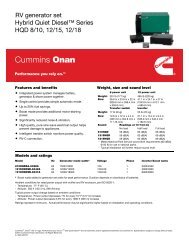Air Brake Manual
Air Brake Manual
Air Brake Manual
Create successful ePaper yourself
Turn your PDF publications into a flip-book with our unique Google optimized e-Paper software.
· Compression stroke: The upward motion of the<br />
piston compresses the air in the cylinder. The rising<br />
pressure cannot escape past the inlet valve (which<br />
the compressed air has closed). As the piston nears<br />
the top of the stroke, the pressurized air is forced<br />
past the discharge valve and into the discharge line<br />
leading to the reservoir.<br />
Compressor (Compression stroke)<br />
Reservoirs<br />
Piston<br />
Discharge<br />
valve<br />
Inlet<br />
valve<br />
To reservoir<br />
Unload plunger<br />
Intake air filter<br />
Reservoirs or tanks hold a supply of compressed air.<br />
The number and size of the reservoirs on a vehicle<br />
will depend on the number of brake chambers and<br />
their size, along with the parking brake<br />
configuration. Most vehicles are equipped with<br />
more than one reservoir. This gives the system a<br />
larger volume of main reservoir air. The first<br />
reservoir after the compressor is referred to as the<br />
supply or wet (5) reservoir. The other reservoirs are<br />
known as primary (8) and secondary (10) or dry<br />
(8)(10) reservoirs. When air is compressed, it<br />
becomes hot. The heated air cools in the reservoir,<br />
forming condensation. It is in this reservoir that most<br />
of the water is condensed from the incoming air. If<br />
oil leaks past the piston rings of the compressor and<br />
mixes with this moisture, it forms sludge, which<br />
accumulates in the bottom of the reservoir. If<br />
allowed to accumulate, this sludge (water and oil)<br />
would enter the braking system and could cause<br />
trouble with valves and other parts. In winter, water<br />
in the system may freeze, causing the malfunction of<br />
valves or brake chambers. Reservoirs are equipped<br />
with drain valves so that any moisture or sludge that<br />
may have accumulated can be drained. If you notice<br />
sludge when draining your system, have it inspected<br />
by a mechanic. To minimize the amount of water<br />
collection, all reservoirs must be drained daily.<br />
Under extreme conditions, reservoirs may have to<br />
be drained more than once a day. To drain the<br />
reservoirs always start with the wet reservoir on the<br />
tractor. Allow all air pressure to escape, which will<br />
then permit the moisture collected in the reservoir to<br />
drain.<br />
Some reservoirs have more than one compartment<br />
and each compartment has its own drain valve,<br />
which must be drained individually. Briefly opening<br />
the valve just to allow some of the air to escape<br />
does not drain the moisture! It is not safe to assume<br />
that the wet reservoir, or the presence of an air<br />
dryer is reason to neglect the other reservoirs on<br />
the power unit, trailers or dollies. They should all be<br />
completely drained daily.<br />
Some reservoirs may be equipped with automatic<br />
reservoir drain valves (spitter valves). These valves<br />
will automatically exhaust moisture from the<br />
reservoir when required, although they should be<br />
checked daily and drained periodically to ensure the<br />
mechanism is functioning properly. Any loose or<br />
disconnected wires associated with the valve<br />
heaters should be repaired immediately.<br />
Reservoir<br />
14




